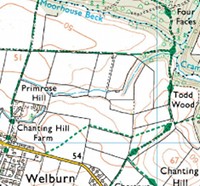Walks
Do I have the right to roam?
Footpaths, rights of way
 It's a common misconception that we now have the right to roam anywhere we like in the countryside.
It's a common misconception that we now have the right to roam anywhere we like in the countryside.
The 2000 Countryside and Rights of Way Act does give us the right to walk freely on certain designated areas or 'open access' land. Even then there are some restrictions.
The good news is that the country is covered by a network of footpaths. Not the tarmac side-of-the-road pavement type footpath, but a public right of way. These are often unsurfaced and cross fields, but the landowners and local authorities have duties to make sure that they remain passable.
There are several different types of path; public footpaths, bridleways, 'Byways Open to All Traffic' ('BOATs'). They have different rules, but all are open to walkers. You have the right to walk a dog on a short lead under close control. If the path crosses a field and there's no obvious path, you're responsible for doing your best to stay close to where the path should be.
A black dotted line denotes a path that has been identified by Ordnance Survey, but not necessarily a right of way because the status is not defined or known.
Generally, there are gates and stiles where the path goes in or out of a field or through a hedge. There will often be a disc with an arrow showing you the general direction of the path, but the only way to be sure that you stay on the right of way is to use a map.
Ordnance Survey maps show these paths as green dotted lines (or pink dotted lines on electronic maps). Creating a circular or linear walk is as simple as 'joining up the dots'!
OS Explorer Maps
1:25,000 scale maps, ideal for walking, running, mountain biking and horseriding. Highly detailed, showing rights of way footpaths, landscape features and places of interest.
Now come with free mobile download.

